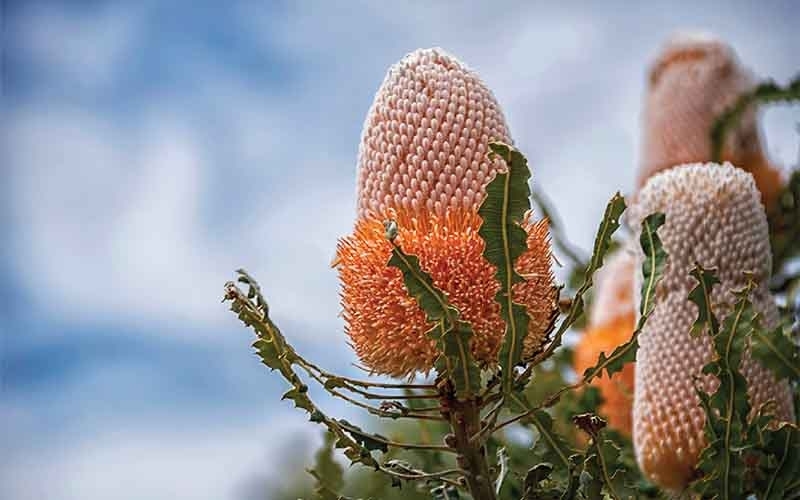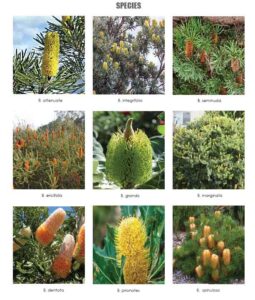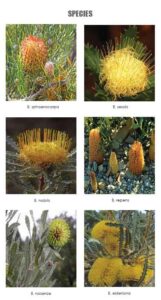Banksia : An Australian Icon

Banksia is a genus of around 170 species of flowering plants in the family Proteaceae. This Australian wild flower and popular garden plant is easily recognised by its characteristic flower spike and woody fruiting “cones” and heads. Banksias range in size from prostrate woody shrubs to trees up to 30 metres (100 ft) tall. They are found in a wide variety of landscapes: sclerophyll forest, rainforest, shrubland and some more arid landscapes, though not in Australia’s deserts. It is having chromosome number, n = 14. The flowers are arranged in flower spikes or capitate flower heads. The character most commonly associated with Banksia is the flower spike, an elongated inflorescence consisting of a woody axis covered in tightly packed pairs of flowers attached at right angles. Banksia flowers are usually a shade of yellow, but orange, red, pink and even violet flowers also occur. The colour of the flowers is determined by the colour of the perianth parts and often the style. The style is much longer than the perianth, and is initially trapped by the upper perianth parts.
IMPORTANCE
Heavy producers of nectar attract birds and small mammals. They are an important food source for all sorts of nectarivorous animals, including birds, bats, rats, possums, stingless bees and a host of invertebrates.
USES
Gardening: Most of species are shrubs, only few of them can be found as trees, the shrubs used are B. grandis, B. prionotes, B. marginata, B. coccinea, B. speciosa and B. menziesii. Due to their size, showy flower heads these species are popularly planted in parks, gardens and streets, the remaining species in this genus are only shrubs.
Cut flower industry, Woodworking: Banksia wood is reddish in color with an attractive grain but it is rarely used as it warps on drying. It is occasionally used for ornamental purposes in wood turning and cabinet paneling.

ENVIRONMENT REQUIREMENTS
Soil: Banksias grow well in deep, well drained, slightly acidic sands (PH 5.5-6.5). Highly alkaline soils are avoided.
Climate: full sunlight and excellent air circulation. Banksia isn’t a good choice for moist, humid climates, although tolerance varies depending on the cultivar.
Drainage: Perfect drainage is critical, as banksia flowers are susceptible to root rot, which is usually deadly.
CULTURAL PRACTICES
Soil preparation: If soils are compacted, deep rip the beds to at least 600 mm below the surface. Mound the planting bed where there is an issue with surface drainage.
Propagation: It is propagated seeds, semi-hardwood cuttings and grating.
Planting: Banksia seedlings should be planted in late April to early May, or well before the winter impacts on soil temperature (less than 15°C). Alternatively, the seedlings could be planted in mid-spring, coinciding with increasing soil temperatures.
Spacing: 1.2 m X 4 m is recommended.
Mulching: Use of mulches may aid plant establishment and growth, where organic and non-organic mulches can be used. Organic mulches can be well composted woodchips, coarse sawdust or weed-free straw or cereal stubble.
Irrigation: The key to successful water management of banksias is to not over water plants so they become waterlogged, but to provide sufficient water to recharge the profile.

SPECIAL PRACTICES
Pruning: Pruning is an important management practice used for cultural improvement and productivity. The time of pruning depends on floral season of a species in the region where it is grown.
HARVESTING
To maintain the best quality, banksias should be harvested in the cool of the morning and moved into the packing shed as soon as possible to avoid blooms heating up and dehydrating. Banksias are preferably picked when no more than 20 % of florets open along a bloom. Picking later results in some of older florets drying on the flower, reducing the fresh look. Banksia leaves dry quickly and can’t be readily re-hydrated. Florets are quickly dried if left in the heat for short periods.
DISEASES
Cinnamon Fungus is perhaps the most serious problem. Most Banksias are highly susceptible, grey mould – Botrytis cinerea, shoot tip blight – Drechslera spp., Anthracnose, Armillaria root rot, Verticillium wilt, damping off (in seedlings), scab or cork bark – Elsinoe spp.
PESTS
Pest problems though relatively few, can include : root knot (caused by a nematode), caterpillars (attacking the flowers or occasionally leaves), beetle damage to leaves, birds eating seeds (mainly parrots and cockatoos), insects eating seeds.


